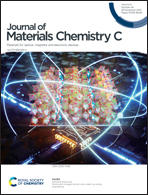Anomalous n-type conversion of thermoelectric polarity in ionic hydrogels using PEDOT:PSS electrodes†
Abstract
With the aid of large Seebeck coefficients, over 1 mV K−1, redox-free ionic conductors have the potential to be used as a component of thermally chargeable supercapacitors and/or thermopiles. To date, most ionic conductors reported exhibit p-type polarity; therefore, it is challenging to develop thermoelectric (TE) supercapacitor modules comprising both p- and n-type TE legs due to the lack of n-type ionic conductors. Herein, we found that the intrinsically p-type polarity of alkylmethylimidazolium chloride (Rmim:Cl)-based ionic hydrogels could be converted into n-type, using poly(3,3-ethylenedioxythiophene):poly(styrenesulfonyl) (PEDOT:PSS)-conducting polymer electrodes. Complementary characterization of the TE voltage response and absorption spectroscopy suggests that “negative” interfacial polarization is induced under asymmetric heating. This results from the ion exchange between PEDOT:PSS and Rmim:Cl upon creating the interfaces and the high affinity of Rmim:PSS compared with PEDOT:Cl, which results in the n-type TE response. Our findings offer a useful method for tuning the polarity of TE supercapacitors by tailoring the ion/electrode interactions despite the use of an identical electrolyte.

- This article is part of the themed collection: Journal of Materials Chemistry C Lunar New Year collection 2022


 Please wait while we load your content...
Please wait while we load your content...